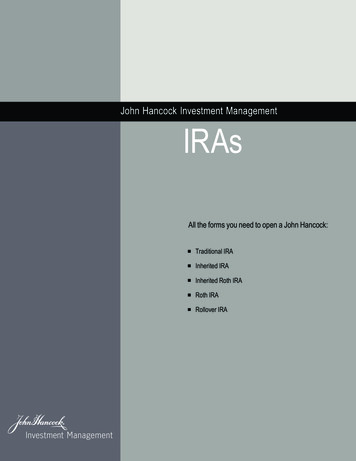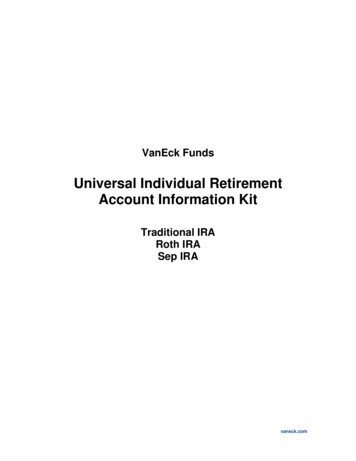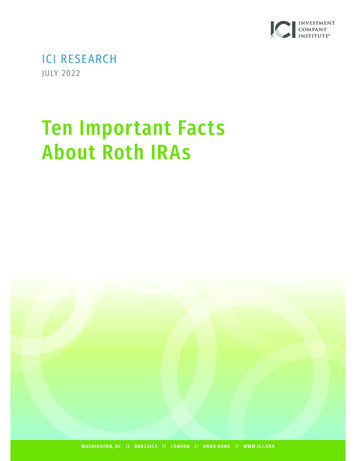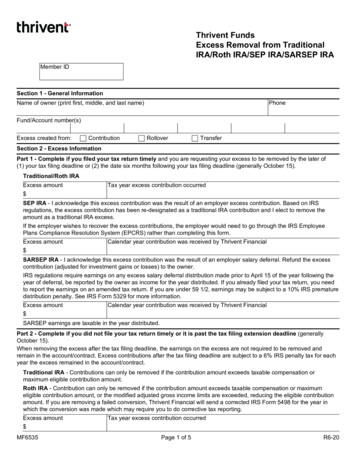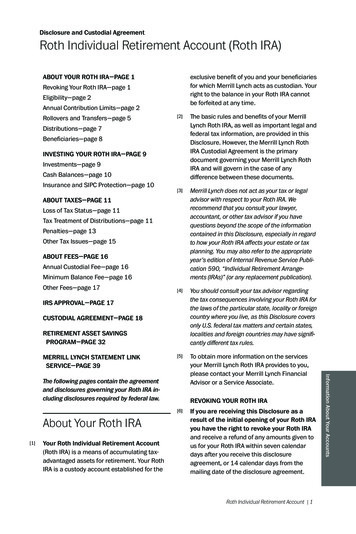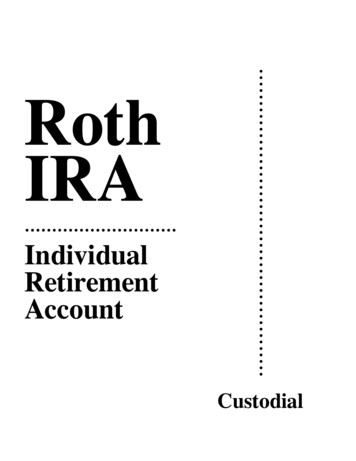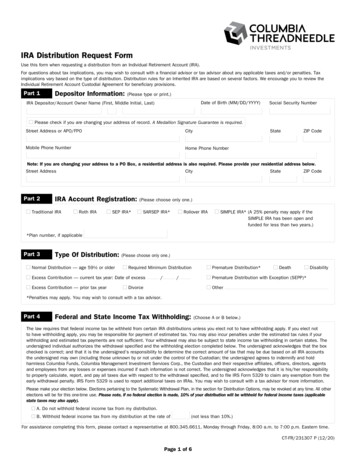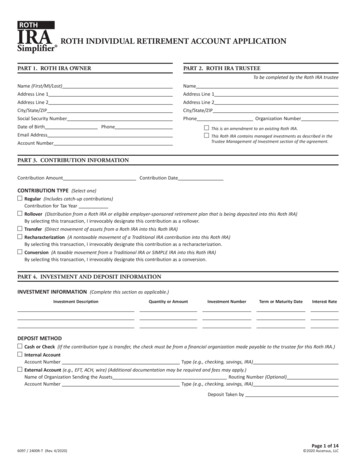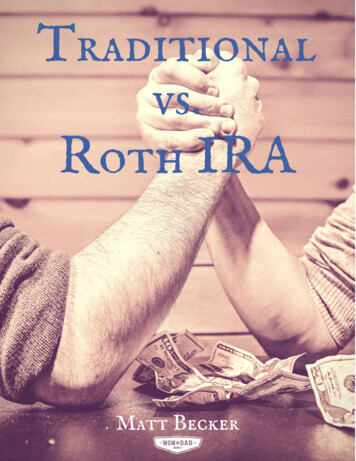
Transcription
Traditional vs. Roth IRA: Some Unconventional Wisdom for Young Investors . 35 Reasons a Roth IRA Might be Right for You . 83 More Unconventional Reasons to Contribute to a Traditional IRA .12About the Author .16Disclaimer .172
When I was fresh out of college and starting my first job, my dad convinced me that I needed tostart saving for retirement. Even if it was just a little bit, getting started early was important.Thanks dad!At the time I was working for a small start-up without an employer-provided retirement plan, so Ineeded to figure things out on my own and quickly found my way to the IRA. What an ingeniouslittle device! A retirement account you can set up on your own and invest pretty much howeveryou want? Pretty cool!So I went about setting one up and quickly found that I needed to make a choice. Did I want toopen a Traditional IRA or a Roth IRA? I went out in search of advice and found the response tobe pretty much unanimous: a Roth IRA was the way to go. The logic was the same no matterwhere I looked and went like this:1. I was young and in a low tax bracket.2. Someday I would be older and in a higher tax bracket.3. Given that, I should pay the taxes now to get tax-free income later.Makes sense right? It did to me. So I opened up a Roth IRA and happily stuffed it with moneyfor years without so much as a second thought.But over the years I continued to learn, and in that time I've discovered that the logic that leadspeople like myself to a Roth IRA is flawed. In fact, the Traditional vs. Roth IRA debate looks alot different when you actually run some numbers and see the results.So today I want to show you the truth behind the Traditional vs. Roth IRA debate in the hopesthat you can make a more informed decision than I did when I started out.Let me get this out of the way. As long as you're saving for retirement you're doing a great job.As I said in my series on how to start investing from scratch, the most important decision youcan make is to get started, not which IRA you choose. That has not changed.With that said, the end goal of investing is to have saved as much money as you need within thetimeframe you need it. If there are easy ways to make that more likely, you should takeadvantage of them.The problem with the conventional wisdom in the Traditional vs. Roth IRA debate is that it'smathematically incorrect, and it therefore leads a lot of people down an inefficient path. It's not abad path, it's just that for many people there is a better one that will help them reach their goalsmore easily.3
In order to explain where the conventional wisdom goes wrong and how we should be thinkingabout it instead, I'm going to have to back up a little bit and make sure we all understand someof the basic definitions first. For that reason, this post will be a little longer than normal, but Ihope you stick with me because the conclusion can make a big difference in your retirementplanning.There are several ways in which a Traditional IRA differs from a Roth IRA, but today I'm onlygoing to focus on the biggest difference. If you'd like a more comprehensive list, includingguidelines for whether you are actually eligible to contribute to either one, you can check out thisresource: Which IRA is right for you?The biggest difference between a Roth IRA and a Traditional IRA has to do with how they aretaxed.Traditional IRA taxationAny money contributed to a Traditional IRA is treated as a tax deduction in the year of thecontribution. This lowers your taxable income for the year, giving you an immediate benefit.As an example, if you're a married couple in the 15% tax bracket and you contribute themaximum 11,000 to a Traditional IRA for 2013, you will save yourself 1,650 in taxes for 2013(0.15*11,000).The flip side is that when you actually reach retirement and start taking money out of theaccount, those withdrawals will all be taxable.Roth IRA taxationThe tax treatment for a Roth IRA is exactly the opposite.Your contributions to a Roth IRA are not deductible and therefore do not save you any moneyon this year's taxes.On the other hand, your withdrawals in retirement are 100% tax-free. In other words, you payyour taxes now in order to be tax-free later.The last thing I want to talk about before I get into the real meat of the comparison is thedifference between a marginal tax rate and an effective tax rate.Don't worry, I'm not going to get too technical here. But understanding this difference is crucialto making a true comparison between a Traditional or Roth IRA.4
A marginal tax rate is the tax you will pay on your last dollar of income. If you're in the 15% taxbracket, your marginal tax rate is 15%. Your last dollar earned was taxed at 15%, and if youearn another dollar it will be taxed at 15%.But you didn't pay 15% in taxes on your entire income. In fact, with the standarddeduction and personal exemptions, there's a good chunk of your income that you didn't payany tax on at all. And because of our progressive tax code, there's another chunk of it that wasonly taxed at 10%. So your effective tax rate is the percent of your total taxes paid over yourtotal income, and will be significantly lower than 15%.Let's look at a simple example of a married couple with 1 child earning 53,000 per year. Theirmarginal tax rate is 15%. But what's their effective tax rate?You can look at my worksheet here to see the calculations, but the end result is that thecouple's effective tax rate is only 6.5%.Okay, now that we've gotten all of those definitions out of the way, it's time for the real meat ofthe article: how you should really be making the decision about contributing to a Traditional IRAvs. a Roth IRA.Please keep in mind that this conversation applies in the same way if you have the choicebetween a Traditional 401(k) and a Roth 401(k).The conventional wisdom behind the Traditional vs. Roth IRA comparison looks at yourmarginal tax rate today against your marginal tax rate in the future. This is wrong.What you need to do instead is compare your MARGINAL tax rate TODAY with yourEFFECTIVE tax rate in the FUTURE.That's because any contributions to a Traditional IRA save you money at your marginal ratetoday, but any future withdrawals are taxed at your effective rate.Let's look at an example. You can follow my calculations and change some of the variables inthis workbook here: Traditional IRA vs. Roth IRA.For this example, I'm going to assume that all of our tax policies will stay the same over theyears. This clearly won't happen, but since we have no idea what WILL happen it doesn't really5
make sense to speculate. I'm also going to ignore inflation, which just makes things morecomplicated and doesn't materially affect the end result.Finally, I’m ignoring the possibility that you have a pension or that you will receive SocialSecurity income, since most young people don’t have a pension and Social Security is sovariable from person to person. The existence of either of those would change the calculationsbelow in favor of a Roth, though not necessarily fully in favor of it.In this example we're using the same married couple we used above making 53,000 with onechild, which puts them in the 15% tax bracket. We're assuming they could contribute themaximum 11,000 per year allowed for a married couple to a Traditional IRA. With a Roth theywould have to pay taxes on that 11,000, so their annual contribution is only 9,350 ( 11,000 *(1 - 0.15)).The conventional wisdom says that the 15% tax bracket is low and they should thereforecontribute to a Roth.So how does it actually play out? Well, when we actually run the numbers, as you can see in thespreadsheet linked above, we discover a few things that really challenge the conventionalwisdom.First of all, after 30 years of saving for retirement the balance in the Roth IRA is 1,143,934.Using the standard 4% withdrawal rule to determine how much they can take out each year inretirement, that would give them a 45,757 annual income in retirement. That is 100% tax-free.With the Traditional IRA, their balance after 30 years is 1,345,805. It's about 200,000 higherbecause they were able to contribute more because of the tax-break. But the withdrawals aretaxable, so that's not the full comparison.To get the final comparison, we have to first calculate the 4% withdrawal for the Traditional IRA,which comes out to 53,832 per year before taxes. Notice that this is almost the same as their 53,000 in income during their working years. (These numbers were not chosen by accident).The conventional wisdom would argue that because your income is essentially the same, andtherefore your marginal tax rate is the same, it shouldn't make a difference whether youcontributed to a Roth or a Traditional IRA. Does that hold up?When we take taxes out of that 53,832 per year, we find out that our withdrawal ends up being 49,650 after-tax. So let's do a quick comparison of the results:I don't know about you, but I would rather have that extra 3,893 of income every year.6
The big reason why the Traditional IRA comes out ahead has to do with the difference betweenmarginal and effective tax rates that we talked about above.In this particular example, the Roth IRA contributions would be taxed at the MARGINAL rate of15%, while Traditional IRA contributions would be tax-free.At the other end, the Roth IRA withdrawals would be tax-free while the Traditional IRAwithdrawals would be taxed at an EFFECTIVE rate of 7.8%.So by going with a Traditional IRA in this example, the couple would essentially be choosing topay 7.2% less in taxes, even though their marginal rate would be the same at each point intime. Over 30 years of saving that adds up to a significant difference.Now let me be clear. This doesn't mean that a Traditional IRA is always better than a Roth IRA.There are many variables that might make your specific situation different from the exampleshown here. Some of those variables will tilt the scales in favor of a Roth IRA. Others will tiltthem in favor of a Traditional IRA. A true personal evaluation will be more nuanced than what'spresented here.But what should be clear is that the conventional wisdom behind the Traditional vs. Roth IRAdebate is wrong. You cannot simply compare your tax rate now to your expected tax rate in thefuture. Doing so drastically underestimates the value of a Traditional IRA.One of the biggest financial decisions you will make is how to save for retirement. My hope isthat this helps you make a more informed decision.7
Last week I wrote an article debunking some of the conventional wisdom around the Traditionalvs. Roth IRA comparison. Today’s post will refer to that one frequently, so if you haven’t read ityet you might want to before continuing on (link: Traditional vs. Roth IRA: Some UnconventionalWisdom on Which is Better for Young Investors).In that post, we came to the conclusion that a Traditional IRA can often be much more favorablethan it’s often considered to be, even for young investors and even for people currently in lowtax brackets (people for whom the Roth is almost universally recommended).It would be easy to walk away from that article and feel like the Traditional IRA is now thedefinite way to go, but as is true with most things it’s almost never that simple.There are plenty of situations where a Roth IRA can be a good idea and I’d like to run throughsome of them today.To fairly compare a contribution to a Traditional IRA with one to a Roth IRA, you can’t comparecontributions of the same amount. In other words, a contribution of X to a Traditional IRA isreally not the same as a contribution of that same X to a Roth IRA because a Traditionalcontribution is tax-deductible (but will be taxed later) while a Roth contribution is after-tax (butwill not be taxed later). The current tax savings you get from a Traditional contribution meansyou can fit a bigger contribution in your budget.This was illustrated in my previous article comparing a Traditional with a Roth IRA with theexample in which a married couple was deciding between either maxing out their TraditionalIRA ( 11,000), or contributing the equivalent after-tax amount to a Roth IRA ( 9,350 in theexample with a 15% tax bracket). An alternative way to compare equivalent after-taxcontributions would be to compare an 11,000 Roth IRA contribution with an 11,000Traditional IRA contribution PLUS an investment of the tax savings offered by that Traditionalcontribution.But the reality is that while this is a mathematically correct comparison, people aren’t robots anddon’t often think like this. A lot of people will simply consider that they have X to contribute. Inother words, they’ll be deciding something like whether to put 5,000 into a Traditional IRA or 5,000 into a Roth IRA.If those are the choices, then a Roth IRA wins because you’re contributing more after-taxdollars. 5,000 that will never be taxed is more than 5,000 that will eventually be taxed. Simpleas that.So while we can certainly debate ideologically about which is better based on the technicallycorrect math, in terms of actual behavior many people will end up contributing more after-taxdollars to a Roth IRA than a Traditional IRA simply because the mental accounting is easier.8
If you’re willing to put in some extra effort and add that extra investment on top of yourTraditional IRA contribution, then great! But if not, then the simplicity of maxing out the Roth IRAis likely to be your best bet. It may not be mathematically perfect, but we’re not robots and weshouldn’t expect ourselves to be.I mentioned this a couple of times in the previous article, but only in passing. The example inthat article assumed that your IRA was your only source of retirement income and that simplymay not be true for a lot of people.The reason this matters is that any other income you’re counting on will fill up at least some ofthose lower tax brackets that served to make the effective rate on the Traditional IRAwithdrawals so low. If you have enough other income, then your IRA withdrawals will end upbeing fully taxed at your marginal rate in retirement.The most likely source of income for most people is Social Security. For all of the death knellsthat seem to pop up in the media, Social Security is alive and kicking and many people arecollecting steady paychecks from the government in their retirement. An article from MichaelKitces also informs us that even if NOTHING is done to address the current Social Securityshortfall, we should still be able to receive 70% of our estimated benefits. So it seems likecounting on some amount of Social Security is certainly prudent.If you’d like to know your current estimated Social Security benefits, you can follow theinstructions here: How to Check Your Social Security Benefits.But there are other potential sources of income as well. Some people still have a pension (luckydogs!). Others plan on doing part-time work well into their retirement years. Others will haveinvestments in regular old taxable accounts pumping out interest and dividends each year.The point is that wherever it’s coming from, any income in addition to withdrawals from aTraditional retirement account can increase the effective tax rate on those Traditionalwithdrawals. Depending on what tax bracket that other income takes you into, it could bebeneficial to have some tax-free Roth money to avoid extra taxes.Now to be clear, this doesn’t mean that having other income automatically makes a TraditionalIRA a bad choice. Far from it. It just means that that other income sources need to beconsidered when making the Traditional vs. Roth evaluation for yourself.Just like I talk about the value of diversifying your investments, there can be value in diversifyingthe tax benefits offered by a Traditional account vs. those offered by a Roth accountIn my previous article, I presented the Traditional vs. Roth IRA debate as an either/or decision.The reality is that you don’t have to choose one or the other. You can choose to do a little ofeach and there are certainly arguments for doing so.9
Having some money in a Traditional IRA will give you the opportunity to fill up at least some ofthose lower tax brackets in retirement. This will let you save more in taxes today that you willhave to pay back later.Having some money in a Roth IRA will protect you from some of the risk that either tax rates willrise or that you’ll have enough income in retirement to push you into a higher tax bracket (luckyyou!).Keep in mind that diversification doesn’t have to mean a 50-50 split between the two. It can beany proportion you want. But there is certainly some merit to this type of approach.At its core, a Roth IRA is simply a way for you to pay now for certainty later. The reality is thatwe don’t know what the tax laws will be years down the road, and it can be comforting to knowthat you have some money that you’ll be able to access tax-free.We can run all of the illustrations and do all the math in the world to try and determine whendoing so is the “optimal” decision, but in the end some people just want the assurance of a RothIRA.The Roth IRA has some flexibility built into it that a Traditional IRA doesn’t. We’ll run throughsome of those features here.Availability of contributions – Any contributions you make to a Roth IRA are available for youto withdraw at any time without tax or penalty. In most cases this probably isn’t advisable, butit’s an option that can be useful and isn’t available with a Traditional IRA. If you’d like to readmore about this, see here: Roth IRA as an Emergency Fund – Is it a Good Idea?Continue contributing for longer – Roth IRAs allow you to continue to make contributionspast the age of 70.5. Traditional IRAs do not. This means that if you have earned income later inlife, the Roth can be a good way to continue getting some tax benefits.Required minimum distributions – With a Traditional IRA the government will eventually forceyou to start taking withdrawals, typically at age 70.5. This has the potential to limit your optionsin retirement, and a Roth IRA does not have this requirement.Estate planning – There are various reasons a Roth IRA can be useful for estate planning,particularly if you have money that you want to pass on to children. You can find a goodoverview of those reasons here: Estate planning opportunities with Roth IRA conversions.10
Unfortunately, there is no one-size-fits-all answer to the Traditional vs. Roth IRA debate. Bothhave their merits and as with almost anything else, it requires a personal evaluation of your owncircumstances to determine the right approach for you.11
In the past couple of weeks, we’ve talked about some unconventional wisdom in the Traditionalvs. Roth IRA debate showing a big potential benefit of a Traditional IRA that isn’t oftendiscussed. We then countered that with an article looking at 5 reasons a Roth IRA might be rightfor you.If those two weren’t enough to make your head swim, today I’m going to give you 3 morereasons to consider contributing to a Traditional IRA.My goal with this mini-series is simply to help you make a more informed decision by pushingpast some of the conventional wisdom floating around out there. Retirement planning is animportant part of your family’s future and I think you deserve to know all the facts, not just the 5second sound bites many financial “gurus” like to spit out.So without further ado, here are 3 more unconventional reasons to contribute to a TraditionalIRA.One point that’s often lost in the Traditional vs. Roth IRA debate is that as the law standscurrently, you don’t have to contribute to a Roth IRA right now in order to take advantage of theRoth IRA later. That is, you can contribute to a Traditional IRA today to take advantage of thetax deduction, and then later, at a time of your choosing, CONVERT some or all of that moneyto a Roth IRA. You will pay taxes on any amount you convert, but this can be a HUGE benefit ifdone correctly.Here’s an example:Jack and Jill are a married couple making 75,000 per year, putting them squarely in the 15%tax bracket. Their state also has a 5% income tax, so their total income tax rate is 20%.They could choose to contribute to a Roth IRA this year and lock in that 20% rate on thecontribution. Or they could choose to contribute to a Traditional IRA, save the 20% in taxes, andgive themselves some flexibility.A couple years down the road, let’s say that Jack and Jill have saved some money and decidethat they want to take a big risk. They’re going to quit their jobs and start the business they’vealways dreamed of running together. Exciting, right?Very exciting! But the reality is that they’ll probably have little to no income for the first year, andmaybe even the second year as well. If they have some money in a Traditional IRA (money thatthey saved 20% in taxes on when contributing), they could use those low-income years toconvert some or all of it to a Roth IRA. Yes, there are tax consequences. But because they don’thave other income they could potentially convert at least some of it at a 0% rate (because of thestandard deduction and personal exemptions). They could also do some at the 10% rate. Statetaxes would be in addition to both of those.12
So they would end up being able to put their money into a Roth IRA, money that will never betaxed again, and save EVEN MORE in taxes because they did it on their own schedule througha conversion rather than locking themselves in with a contribution.This opportunity doesn’t only come up when you start a business. There are many reasons whyyou might be in a lower tax bracket in the future and could potentially take advantage of this.Maybe you go through a period of unemployment. Maybe you change careers and temporarilytake a lower salary. Maybe you have a child and one parent decides to stay home. Maybe youretire early.The point here is that the conversion option gives you flexibility and choices, but only if you startwith a Traditional contribution. A Roth contribution locks you into your current tax bracket.As of 2014, there are no income limits and no limit to the amount you are allowed to convert. Sothis option is open to everyone.Update: I actually did this myself in 2014. You can get the details here: Finding the SilverLinings in a Lower Income.When discussing taxes, people often only talk about Federal income tax rates. That is, someonewill say they’re in the 15% tax bracket, meaning they pay 15% in taxes to the Federalgovernment.But there are many states that have an additional income tax, and Traditional IRA contributionsgive you a break on that tax too. Here in Massachusetts the income tax rate is a flat 5.2%, soany Traditional contributions I make save me 5.2% in current taxes in addition to the savings onFederal taxes.Depending on where you live now and what your plans are for later in life, it’s possible that you’llone day live in a state that either has a smaller income tax or no income tax at all (Floridaanyone?). If that’s the case, you could save some real money with a Traditional contribution bygetting the benefit of the deduction in the higher tax bracket today AND the benefit ofwithdrawing in a smaller tax bracket later.As a quick example, as I said above I could save 5.2% in state income taxes by contributing to aTraditional IRA today. If we someday move to Florida (very possible given that my wife is fromPensacola), my Traditional IRA withdrawals would never be subject to state income tax. I wouldhave completely avoided it!It all depends on the personal situation of course, but this is worth considering especially if youcurrently live in a state with high income taxes. Two resources where you can look up incometax rates by state are here and here, though neither was updated for 2015 as of the time of thiswriting.13
Just recently I talked about the saver’s credit, which allows certain people to get a tax break (upto 2,000 per year) when they contribute to their retirement accounts. The saver’s credit is justone of many tax credits and tax deductions that relies on a number called AGI (adjusted grossincome) to determine whether you’re eligible to take it.Your AGI is simply your full income with certain things taken out, like contributions to a taxdeductible retirement account (such as a Traditional IRA or 401(k), not a Roth), contributions toa health savings account, moving expenses, etc. You can see a more complete list here.One of the reasons a Traditional IRA contribution can be so valuable is that it lowers your AGI.And the lower your AGI, the more likely you are to qualify for some really valuable tax creditsand deductions.Here’s a short list of tax breaks that are either reduced or completely eliminated once you reacha certain level of AGI: Saver’s credit: Up to a 2,000 tax credit. Completely eliminated for married couplesonce AGI exceeds 60,000.Child & dependent care credit: Up to 1,050 for one child, 2,100 for two or more. Theamount you can claim decreases with AGI but is never completely eliminated.Medical expense deduction: You can only deduct the amount that exceeds 10% ofyour AGI (7.5% if you or your spouse are 65 or older). Obviously, the lower your AGI, thelower the threshold.Dividends and capital gains: This isn’t actually a credit or deduction, but taxpayers inthe 15% tax bracket or lower don’t have to pay taxes on these. So lowering your taxableincome with a Traditional contribution can definitely help here.There’s another number, called Modified AGI (MAGI), that adds certain things back to AGI andis used to determine eligibility for other credits and deductions. One of the things that getsadded back are any IRA deductions, which slightly lessens the value of the Traditional IRA. ButTraditional 401(k) contributions still help you qualify, so if your Traditional vs. Roth decision is ina 401(k) you should keep these additional tax breaks in mind: Child tax credit: Up to 1,000 per child. Starts phasing out for married couples at MAGIof 110,000.American opportunity tax credit: Up to 2,500 per student for qualifying educationexpenses. Completely eliminated for married couples once MAGI exceeds 180,000.Lifetime learning credit: Up to 2,000 per family for qualified education expenses.Completely eliminated for married couples once MAGI exceeds 128,000.There are plenty more, and you should talk to a tax professional if you want to understand whichmight specifically apply to your personal situation.14
As we’ve said many times by now, the final decision in the Traditional vs. Roth debate dependsvery much on your own personal financial situation. My goal in this mini-series was simply togive you some things to think about when making the decision that maybe you hadn’tconsidered before.15
Hi, I'm Matt Becker. I'm a fee-only financial planner and thefounder of Mom and Dad Money, where my mission is tohelp new parents build a better financial future for theirfamilies.I have two young boys myself, so I know first-hand how hardit can be to handle all the new financial responsibilities thatcome with starting a family. It's not easy to figure out whatyou're supposed to be doing, how to prioritize everything,and how to fit it all within a limited budget. And when you addall that on top of the challenge of caring for your children, itcan create a lot of stress, anxiety and maybe even sometension between you and your partner.I created my practice to make all of that easier and lessstressful for you. Every day I help new parents just like you to set financial goals, create aspending plan that actually works, get the right protections in place, and start saving for thefuture. I know how confusing it can be to navigate all of that yourself (my wife and I had plenty oftrouble ourselves), so my role is to act as an objective advisor who can help you see the bigpicture and figure out how all the pieces fit together. With the right plan in place, my clientsspend less time worrying about money and more time enjoying their growing families.If you would like someone to talk to about your money questions, I invite you to schedule a free,no-obligation phone call so that you can tell me a little more about your situation. Even thesimple act of talking about your struggles and concerns can bring you a lot of relief, so pleaseclick the button below to schedule your call.You can also go directly to this URL, http://momanddadmoney.com/consult, or just shoot me anemail at matt@momanddadmoney.com and we'll work it out.I'm looking forward to talking to you soon!16
The information contained in this guide is for informational purposes only.Any legal or financial advice that I give is my opinion based on my own experience. You shouldalways seek the advice of a professional before acting on something that I have published orrecommended. Any personal results disclosed in this guide should not be considered average.The material in this guide may include information, products or services by third parties. ThirdParty Materials comprise of the products and opinions expressed by their owners. As such, I donot assume responsibility or liability for any Third Party material or opinions.The publication of such Third Party Materials does not constitute my guarantee of anyinformation, instruction, opinion, products or services contained within the Third Party Material.The use of recommended Third Party Material does not guarantee any success. Publication ofsuch Third Party Material is
Roth IRA taxation The tax treatment for a Roth IRA is exactly the opposite. Your contributions to a Roth IRA are not deductible and therefore do not save you any money on this year's taxes. On the other hand, your withdrawals in retirement are 100% tax-free. In other words, you pay your taxes now in order to be tax-free later.
